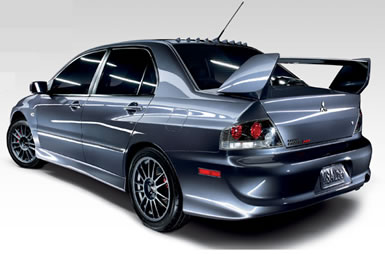|
|

San Francisco:
The Mitsubishi Lancer is a modest, compact four-door sedan that
would be perfect for sending your daughter off to college in. Adding the
word Evolution to the trunk lid badge changes the car completely. The
Evolution, affectionately known as the Evo, is a super car designed for
winning road rallies. It has long been revered in Japan for its road
going prowess.
The recipe for making an Evo goes something like
this:
A - Select one fresh Mitsubishi Lancer
B - Double the horsepower (and then some)
C - Add computer-assisted all-wheel-drive
D - Add numerous suspension enhancements
E - Add powerful, high-tech braking
F - Put in body-gripping Recaro seats
G - Install a monster carbon-fiber rear wing
H - Stir in lightweight Enkei alloy wheels
I - Mix with other special spices
J - Bake on the Nurburgring racetrack until done
Mitsubishi Racing has been around for 35 years, but
we only got the Evo here in 2003. For 2006, the ninth iteration offers
many worthwhile enhancements to make the car handle better and drive a
little more comfortably. Horsepower got bumped slightly, and the power
is available at lower rpm thanks to revised variable valve timing. They
also performed some modest restyling to the front fascia and the
lighting on both ends.
My Electric Blue sample sat menacingly in my
driveway, attracting my car-savvy 15-year-old neighbor, Peter. I took
him out for a little run around the neighborhood. We zoomed up and down
hills like a roller coaster and had a great time.
While Peteís eyes bugged out at the performance and
the appearance of my test unit, my wife was less impressed. While this
latest Evo has numerous improvements to make it a more comfortable daily
driver, it is still a serious sports sedan, and you will feel the road
surface and sense every turn in your guts. That can be exhilarating or
exhausting, depending on your perspective.
The heart of this super car is a modest 2.0-liter
four-cylinder engine, but an intercooled, twin-scroll turbocharger makes
all the difference, pushing output to 286 horsepower. The hood has
prominent vents to let out the heat generated by this power-building
process.
The engine uses Mitsubishi Innovative Valve timing
and Electronic Control (MIVEC) to provide maximum power across all parts
of the rev band. The engine generates 289 lb-ft. of torque at 3500 rpm,
which is a very large quantity in a compact sedan.
There are three Evo models for 2006. My tester was
the regular one, the IX, but there is also an RS model, which is the
lightest and is geared for the racetrack. The MR model (it stands for
Mitsubishi Racing) is the top dog, with numerous enhancements, including
an aluminum roof (shared with the RS), specially-developed shocks,
lightweight BBS alloy wheels, and a six-speed manual transmission.
Inside, the MR gets an aluminum shift knob, aluminum and carbon fiber
brake lever handle, and special red badging.
All Evos benefit from the Active Center
Differential (ACD) all-wheel-drive system, which helps put all that
power to the road efficiently and safely. The ACD system uses a center
differential to split torque up to 50/50 between the front and rear
wheels. The carís computer system uses sensor data to make instantaneous
adjustments depending on driving conditions. The driver can select
between three modes, Tarmac (dry road), Gravel (loose dirt), and Snow
(wet & icy). As I was on dry roads for the entire test week I didnít
make any adjustments, but surely any rally driver would find this very
useful.
The Evoís interior is a mixture of basic Japanese
efficiency and ordinary materials on one hand and sports car equipment
on the other. Sometimes, the Lancerís humble origins become apparent,
despite nice touches like the leather Recaro racing seats, metal pedals,
and leather wheel and shift knob. But as soon as you put your foot into
that right-hand pedal, all is forgotten in the whoosh of speed. You can
grab a quick thrill on freeway onramps and hasty blasts away from the
bridge tollbooth. I also visited some favorite back roads to sample the
cars potential. You will see triple digit speeds without much effort on
a straightaway, but as my course was winding, I had a chance to enjoy
some absolutely flat cornering and level acceleration and deceleration.
I didnít take my wife on this trip.
Unless you can appreciate all the technology and
expensive materials that sit under the car, you might find the pricing
of the Evo a bit hair-raising. The IX comes to $31,994, including the
shipping charges. The RS, a bit decontented for racing purposes, comes
in at $29,274. For the full-boat, maximum energy MR, plan on paying
$35,784. There are some other very interesting vehicles for sale at that
price, but other than a competing Subaru model, you canít really find
anything else like it at any price. By
Steve Schaefer © AutoWire.Net - San Francisco

Mitsubishi Home Page
Byline: Syndicated content provided by Tony Leopardo ©
AutoWire.Net
Column Name: You
canít really find anything else like it at any price
Topic: The
2006 Mitsubishi Lancer Evolution IX
Word Count:
897
Photo Caption:
The 2006 Mitsubishi Lancer
Evolution IX
Photo Credits:
Mitsubishi Internet Media
Series #:
2005 - 61
Download
the Microsoft Word version here:
2006
Mitsubishi Lancer Evolution IX
Download the Original Image File here:
2006 Mitsubishi Lancer
Evolution IX


|
